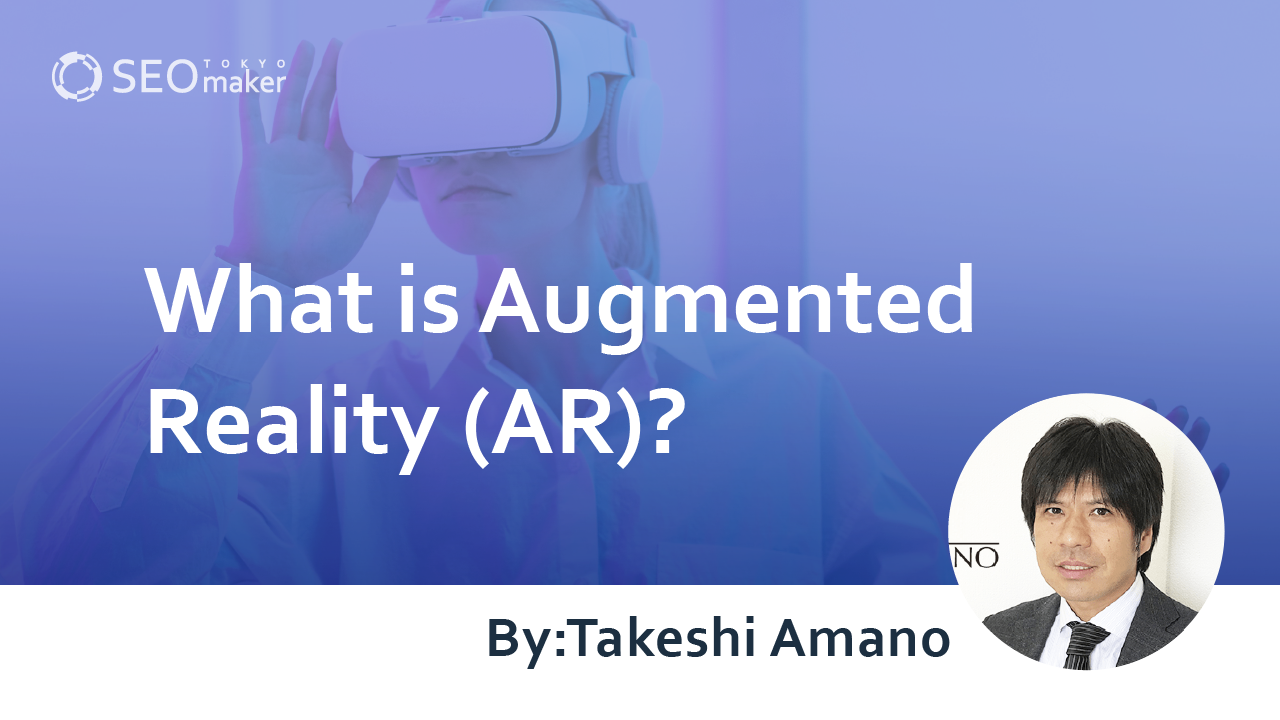What is Augmented Reality (AR)? : 8 Marketing Strategies Utilizing AR
contents

Augmented Reality (AR) is a technology that overlays computer-generated imagery (CGI) onto real-world imagery displayed on smartphones, enabling the depiction of virtual spaces.
Traditionally, AR has been utilized in specific fields like gaming. However, in recent years, it has been increasingly adopted as a marketing strategy across a wide range of sectors, including sports, bridal, and training.
In this article, we’ll delve into marketing strategies leveraging Augmented Reality (AR), discussing the merits, drawbacks, strategy formulation, and detailing eight case studies.
What is AR (Augmented Reality)?
AR, or Augmented Reality, refers to the technology of creating virtual spaces in the real world by superimposing computer-generated images or videos onto real-world images or videos. It enhances the real world by projecting virtual elements onto it.
For instance, by overlaying CGI onto video footage captured by a smartphone, it becomes possible to depict non-existent objects as if they were real.
Common examples of AR applications include apps that alter faces during filming or apps that allow users to preview products in stores through their smartphone cameras. It’s safe to say that AR-based services have become increasingly prevalent in recent years.
Here, we’ll explore the features of Augmented Reality (AR) while comparing it to Virtual Reality (VR)
Differences from Virtual Reality (VR)
Virtual Reality (VR) is often confused with Augmented Reality (AR). VR, short for ‘Virtual Reality,’ refers to the technology that creates a virtual world where users can have experiences similar to real life.
For example, entering the world of a game and playing in a virtual environment using visual and auditory stimuli is an example of VR. Another characteristic feature is the ability to experience footage in 3D space through dedicated VR goggles, achieved by capturing 360-degree videos.
However, unlike AR, which overlays virtual spaces onto the real world, VR does not allow users to experience a virtual world in the same way. Instead, it creates an entirely virtual environment separate from the real world, making the real world merely the reference point and the virtual space an added value.
Types of Augmented Reality (AR)
While AR projects virtual spaces onto the real world, there are various processes involved in displaying digital content such as images, objects, and spatial recognition.
Here, we’ll explain the four types of AR
-GPS-based AR
-Marker-based AR
-Object recognition-based AR
-Spatial recognition-based AR
GPS-based AR
GPS-based AR uses location information obtained from devices like smartphones to display digital content. It’s applicable in scenarios such as;
-Map apps
-Location-based games
-Architectural structures
-Tourist destinations
Features include the ability to trigger digital content based on reaching specific locations. It can also incorporate additional data such as direction and device acceleration, offering versatility across different situations.
However, the accuracy of location information is crucial, and if GPS malfunctions, there may be drawbacks such as failure to display content.
Marker-based AR
Marker-based AR involves recognizing pre-registered markers to display digital content. It’s applicable in scenarios such as;
-Real-world events
-Physical stores
-Image-based social media
-Product catalogs
When the marker is detected, digital content is automatically displayed, making it easy to recognize and accurately display content. Moreover, the preparation involves only providing the marker image or photo, making it convenient to create AR content.
However, since the content is only displayed when the marker is recognized, it may not be usable depending on environmental factors such as illumination.
Object Recognition-based AR
Object recognition-based AR involves recognizing specific objects to display pre-set digital content. It’s applicable in scenarios such as;
-Products or packages
-Industrial fields like automobiles or machinery
-Figures or toys
Since it recognizes objects in 3D, it can be utilized for three-dimensional objects like figures or toys. Therefore, even in situations where physical markers cannot be placed, content information can be set up as AR, which is a distinctive feature.
However, object recognition-based AR requires specialized work regarding 3D data, making it challenging to introduce easily.
Spatial Recognition-based AR
Spatial recognition-based AR involves recognizing three-dimensional information in space to display pre-set digital content. It’s applicable in scenarios such as;
-Real-world events
-Games
-Furniture, appliances
-Industrial sectors like architecture
By recognizing real-world dimensions such as height and depth through cameras and sensors, content information tailored to real-world sizes is displayed. This technology can be utilized for scenarios where real-world placement confirmation is necessary, such as furniture or appliances, demonstrating its wide range of applications.
Moreover, with advancements like embedding AR in glasses akin to VR goggles, there’s promising potential for the future of this technology
The Benefits of Utilizing Augmented Reality (AR) in Marketing
The advantage of using AR in marketing lies in the ability to create services that haven’t existed before, thereby offering customers new experiences and excitement.
For example, for a company manufacturing and selling furniture, traditional customers needed to measure the placement of products before visiting the store. However, by leveraging AR’s spatial recognition, customers can now determine if the store’s products fit within their homes.
This not only eliminates the need for measurements but also removes the necessity to visit the store, providing a completely new experience.
By offering entirely new services that differ from traditional methods, customer satisfaction can be enhanced due to freshness and convenience, making it an effective marketing strategy.
The Drawbacks of Utilizing Augmented Reality (AR) in Marketing
One disadvantage of using AR in marketing is the potential to cause significant societal confusion depending on how it’s utilized.
For instance, in gaming apps, which are one of the reasons AR technologies gained attention, new games were downloaded at an astonishing speed, acquiring many users.
While it may be a successful marketing strategy, it has also led to societal problems such as distracted walking or trespassing on private property.
Currently, due to the limited use of AR-based content, societal norms haven’t been firmly established. What may have been intended as a marketing effort could inadvertently lead to significant issues.
Therefore, it’s essential to not only consider the company’s interests but also anticipate the expansion of customer use and pay attention to societal issues.
Developing Augmented Reality (AR) Marketing Strategies
When considering AR marketing strategies, follow these steps
-Understand market demand and trends
-Focus on experiences rather than content
-Consider how products appear from the customer’s perspective
Let’s explain each of these steps
Understanding Market Demand and Trends
When devising AR marketing strategies, it’s crucial to first understand the market demand and trends.
It’s essential to review the business environment to understand the situation of the target market and how the surrounding environment is changing.
Even if you come up with excellent ways to utilize AR, if competitors have already achieved results, your company may not be able to expect effectiveness.
As customer needs are constantly changing, consider the optimal approach for strategy development, taking into account the market, competition, and timing.
Focus on Experience Rather Than Content
In AR marketing strategies, focus on providing experiences to customers rather than just content.
While typical content focuses on disseminating useful information based on customer needs, in AR marketing, the strength lies in providing customer experiences.
Through experiences, you can convey the appeal of products or services that couldn’t be conveyed before, such as information that couldn’t be conveyed previously or atmospheres that can only be felt in reality.
Therefore, instead of focusing solely on the information to be conveyed, base your strategies on the process of utilizing content and the information or values obtained after utilization.
Consider How Products Appear from the Customer’s Perspective
This relates to the previous point, but after considering content as part of AR marketing, always think about how products appear from the customer’s perspective.
When devising strategies for marketing, even if you can provide excellent experiences, if they don’t connect to your company’s products or services, it becomes meaningless.
For example, in an app where you can virtually place furniture in your home, if the furniture sizes don’t match, you’ll need to suggest alternative sizes to avoid losing customers.
Consider the emotions evoked through content and devise a process towards the final goal.
8 Selected AR Marketing Strategies
Here, we’ll delve into 8 detailed examples of AR marketing strategies.
-Tourism
-Real Estate
-Bridal
-Sports
-Retail
-Sales
-Training
-Social Media
Tourism
In the tourism sector, traditional methods like brochures and leaflets are commonly used to increase awareness of tourist destinations. However, due to the limited information that can be conveyed through print media, combining AR can effectively convey specific images and atmospheres of tourist spots.
Strategies include;
-Utilizing stamp rallies in brochures to display the history of tourist destinations through AR content linked to location information.
-Placing markers at designated locations in brochures so that tourist attractions are projected when viewed through a camera.
-Displaying mascot characters when brochures are viewed through a camera.
Real Estate
In the real estate sector, conveying information through floor plans and property photos only provides limited information. Therefore, leveraging AR to represent properties in three dimensions can effectively showcase the attractiveness of properties and promote them.
Strategies include;
-Viewing AR videos of property information when markers on brochures or leaflets are scanned.
-Viewing three-dimensional floor plans when they are projected through the camera.
-Displaying completed images in actual size when viewing the land planned for construction through a camera.
In the real estate sector, where physical location and space have a significant impact, AR marketing offers a wide range of possibilities.
Bridal
In the bridal sector, many customers want to physically confirm their choices before making decisions. Therefore, strategies that convey information close to reality through AR are effective. Specifically, AR marketing can be utilized for promoting wedding dresses and wedding venues.
Strategies include;
-Placing markers in bridal magazines so that when viewed through a camera, actual-size dresses are projected.
-Viewing AR videos of wedding venues when wedding catalogs are viewed through a camera. -Experiencing wedding day arrangements through AR videos, such as balloon releases.
Sports
The sports sector is one of the fields where AR marketing is widely used. For example, aiming to increase the number of visitors to domes and stadiums, strategies involve providing experiences that can only be enjoyed within the facilities through AR content.
Strategies include;
-When posters inside the facility are viewed through a camera, life-size athletes are displayed.
-Distributing original AR content simultaneously with the start of the game by setting location information and time.
-Implementing an AR stamp rally by placing markers in designated locations within the facility.
Retail
In the retail sector, effective strategies involve implementing measures that allow customers to confirm product fittings and textures without visiting physical stores, completing the process from product selection to purchase online.
Strategies include;
-Virtual fitting systems on smartphones.
-When viewing home interiors through a camera, selected products are displayed in actual size.
-Viewing detailed product information when markers on brochures are viewed.
Given the expansion of the online shopping market, AR-based marketing strategies have high compatibility and are recommended as a means to promote product sales.
(h3)Sales
In the sales field, paper-based materials such as sales documents and brochures are commonly used. Although AR may seem challenging to incorporate at first glance, using AR videos or content instead of paper media can be effective in leaving a lasting impression of your company and deepening understanding of your products as a strategy.
Strategies include;
-Placing markers on sales materials or business cards, which, when viewed through a camera, display company information or personal introductions.
-Viewing catalogs through a camera to display products in actual size.
Training
In training, utilizing AR is effective for practicing responses to irregular situations and performing practical tasks that cannot be carried out in reality.
There are limitations to what can be learned through training, especially tasks that require working with a supervisor. However, by utilizing AR, the scope of training can be expanded, contributing to an image strategy of being a company with a comprehensive training system.
Strategies include;
-Virtual surgery using AR in medical settings
-Simulated experiences of accidents that commonly occur in the field.
Social Media
Social media is a field where AR technology is widely used and readily accessible.
Although AR technology is commonly used when using the camera, it is also widely used in various other aspects such as AR advertising. Companies can effectively utilize AR advertising on social media platforms as part of their promotional strategy.
AR advertising tends to attract more attention than conventional web advertisements, making it effective in improving brand awareness. It also helps to imprint a positive impression of the company, making it a recommended strategy for corporate branding considerations.
Summary
In this article, we have discussed AR marketing strategies, including their advantages, disadvantages, how to develop strategies, and detailed explanations of eight case studies. While marketing strategies vary by field, the fundamental concept of providing experiences remains consistent. With four types of AR available, consider which technology will provide the most impactful experience for your customers, and design product introductions and marketing strategies accordingly.










![What is a Description? Explaining the Meaning, Writing Style, and Changing Word Count – [2023 Edition]](https://www.switchitmaker2.com/en/wp-content/uploads/2024/09/what-is-description.webp)










